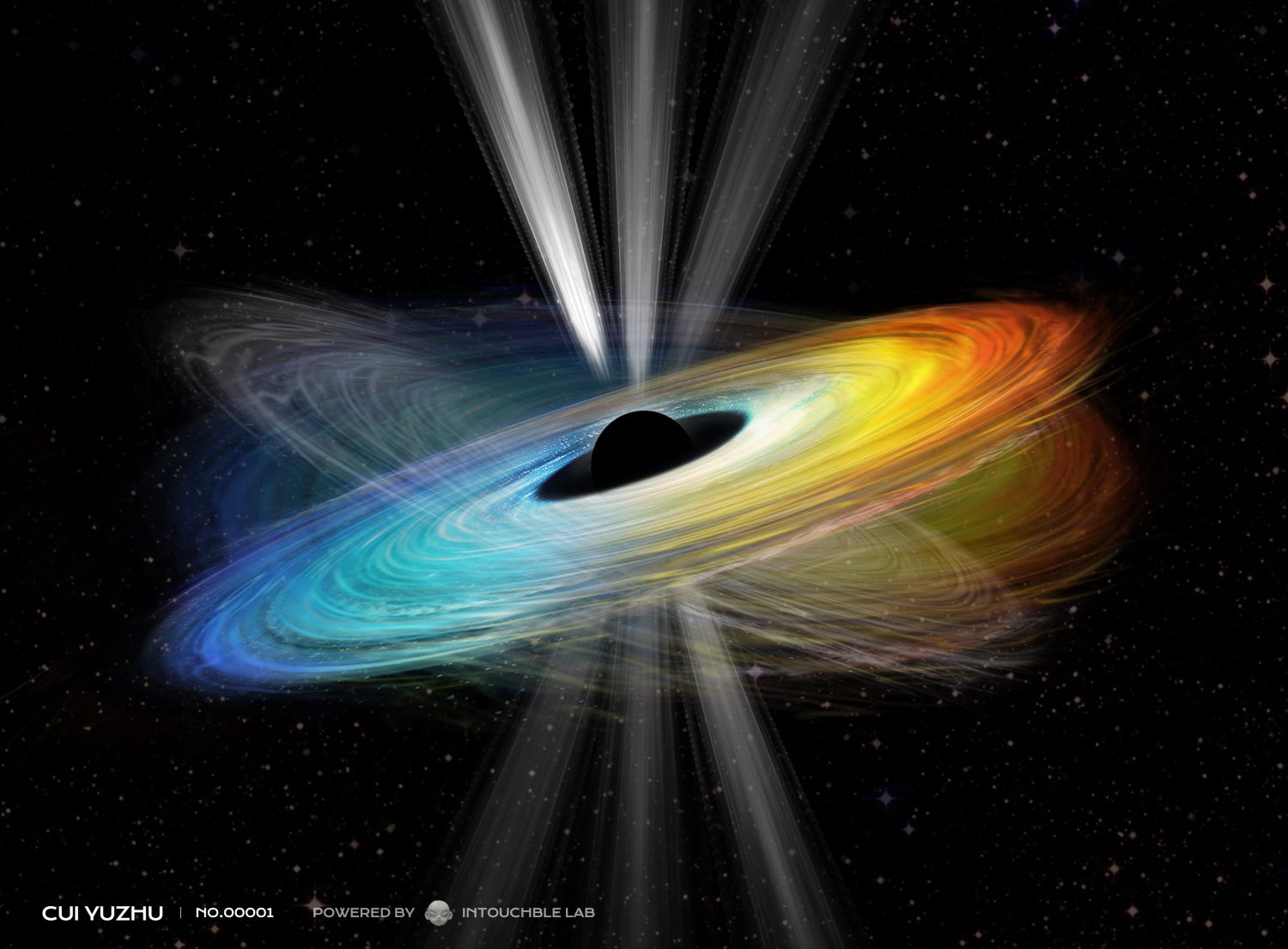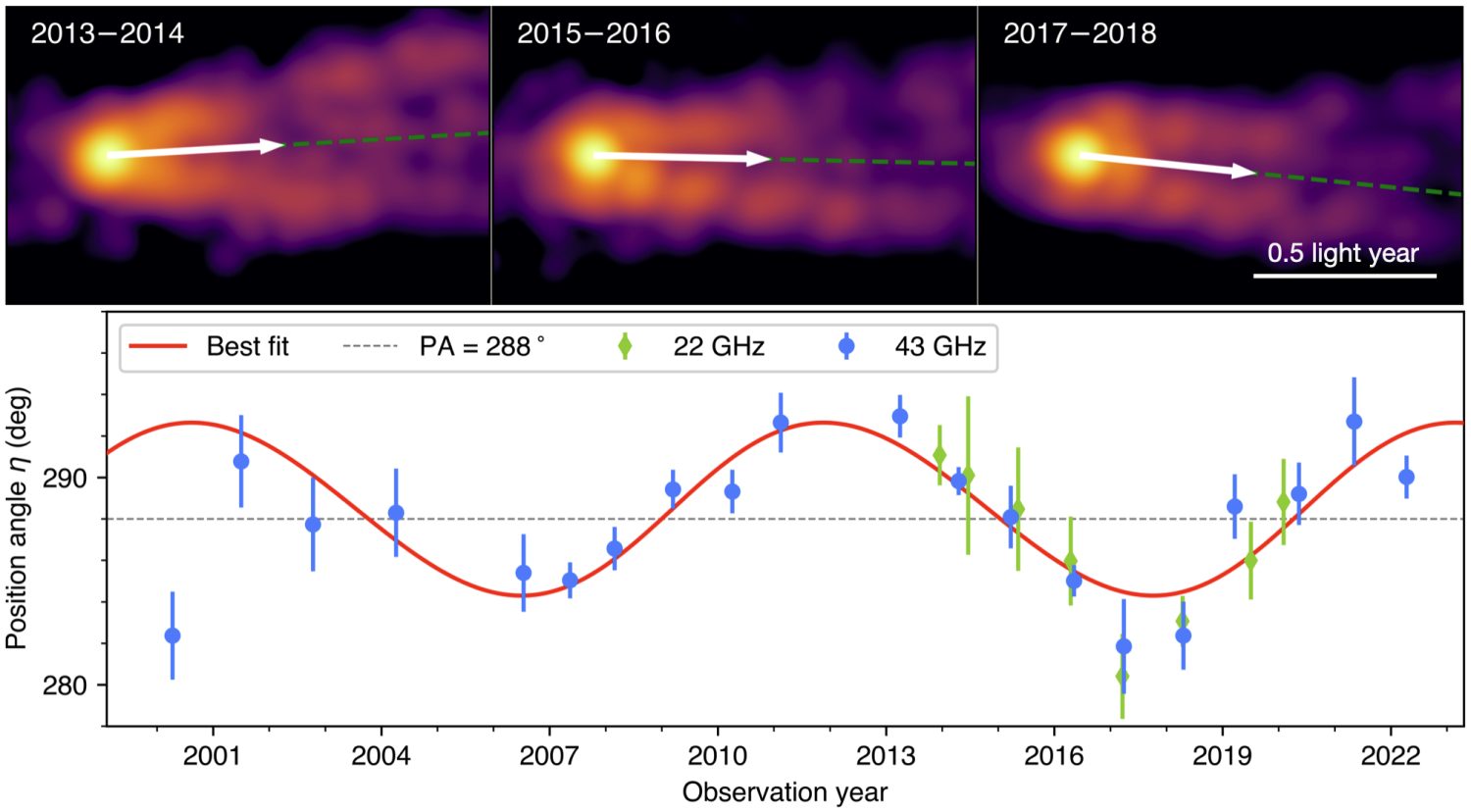Two-decade monitoring of M87 unveils a precessing jet connecting to a spinning black hole
The nearby radio galaxy M87, located 55 million light-years from the Earth and harboring a black hole 6.5 billion times more massive than the Sun, has recently been discovered to exhibit an oscillating jet. This investigation found the jet swinging up and down with an amplitude of about 10 degrees. Through the extensive analysis of data observed from 2000 to 2022 by various international networks of radio telescopes, the research team unveils a recurring 11-year cycle in the precessing motion of the jet base, as predicted by Einstein’s general relativity. This work successfully linked the dynamics of the jet with the central supermassive black hole, offering the evidence for the existence of M87’s black hole spin. The work is published in the current issue of Nature.
 Figure 1. Schematic representation of the tilted accretion disk model. The black hole spin axis is assumed to align vertically. The jet direction stands almost perpendicular to the disk plane. The misalignment between the black hole spin axis and disk rotation axis triggers the precession of disk and jet. Credit: Yuzhu Cui et al. (2023), Intouchable Lab@Openverse and Zhejiang Lab.
Figure 1. Schematic representation of the tilted accretion disk model. The black hole spin axis is assumed to align vertically. The jet direction stands almost perpendicular to the disk plane. The misalignment between the black hole spin axis and disk rotation axis triggers the precession of disk and jet. Credit: Yuzhu Cui et al. (2023), Intouchable Lab@Openverse and Zhejiang Lab.
Supermassive black holes at the center of active galaxies, the most disruptive celestial objects found in our universe, can accrete tremendous amounts of materials onto them due to the extraordinary gravitational force and power the plasma outflow like jets to nearly the speed of light extending to thousands of light-years away. The energy transfer mechanism among supermassive black holes, accretion disk, and relativistic jets have been puzzling physicists and astronomers for over a century. A prevailing theory suggests that energy can be extracted from a spinning black hole, allowing some materials surrounding the supermassive black hole to be ejected with great energy. However, the spin of supermassive black holes, a crucial factor in this process and the most fundamental parameter other than black hole mass, has not been directly observed.
To tackle this challenging question, the research team focuses on M87 which is the first observational record of an astrophysical jet in 1918. Thanks to its proximity, the jet formation regions close to the black hole can be detailedly resolved with Very Long Baseline Interferometry (VLBI), as represented by the recent black hole shadow imaging with the Event Horizon Telescope (EHT). By analyzing M87 VLBI data obtained over the last 23 years, the team has detected the periodic precessing jet at its base (Figure 2), which can bring us an insight into the status of the central black hole.
At the heart of this discovery lies the critical question: what force in the universe can alter the direction of such a precessing jet? The answer could be hidden in the behavior of the accretion disk, the configuration related to the central supermassive black hole. As infalling materials orbit the black hole due to their angular momenta, they form a disk-like structure before gradually spiraling inwards until they are fatefully drawn onto the black hole. However, if the black hole is spinning, it exerts a significant impact on the surrounding spacetime, causing nearby objects to be dragged along its axis of rotation, namely “frame-dragging” predicted by Einstein’s General Relativity.
 Figure 2. (Top panel) M87 jet structure at 43 GHz averaged over every two years from 2013 to 2018. The corresponding years are indicated at the left-top corner. The white arrows indicate the jet position angle in each subplot. (Bottom panel) Observed evolution of jet direction between 2000 and 2022. The green and blue points are obtained from observations at 22 and 43 GHz. The red line represents a best-fit sinusoidal curve with a period of 11 years. Credit: Yuzhu Cui et al. (2023)
Figure 2. (Top panel) M87 jet structure at 43 GHz averaged over every two years from 2013 to 2018. The corresponding years are indicated at the left-top corner. The white arrows indicate the jet position angle in each subplot. (Bottom panel) Observed evolution of jet direction between 2000 and 2022. The green and blue points are obtained from observations at 22 and 43 GHz. The red line represents a best-fit sinusoidal curve with a period of 11 years. Credit: Yuzhu Cui et al. (2023)
The research team’s extensive analysis, including a comparison with a state-of-the-art theoretical simulation using a supercomputer, indicates that the rotation axis of the accretion disk misaligns with the black hole’s spin axis, leading to a precessing jet. Detecting this precession serves as a compelling support, providing unequivocal evidence that the supermassive black hole inside M87 is indeed spinning, unlocking new dimensions in our understanding of the nature of supermassive black holes.
“We are thrilled by this significant finding,” said Yuzhu Cui, a postdoctoral researcher at the Zhejiang laboratory and the leading and corresponding author of the paper. “Since the misalignment between the black hole and the disk is relatively small and the precession period is around 11 years, accumulating high-resolution data tracing M87 structure over two decades and thorough analysis are essential to obtain this achievement.”
This work made use of a total of 170 epochs of observations obtained by the East Asian VLBI Network (EAVN), the Very Long Baseline Array (VLBA), the joint array of KVN and VERA (KaVA), and the East Asia to Italy Nearly Global (EATING) VLBI network. In total, more than 20 radio telescopes across the globe contributed to this study.
Prof. Kotaro Niinuma at Yamaguchi University, a member of the EAVN AGN sub-working group, made the following comment. “This is a very significant scientific achievement that has been obtained through the research team’s steady and continuous observations. The result obtained through the continued efforts of the research team may lead to a deeper understanding of the relationship between black hole spin and the driving mechanism of jets, which has been a long-standing mystery.”
While this study sheds light on the mysterious world of a supermassive black hole, it also presents formidable challenges. The disk’s structure and the exact value of the M87 supermassive black hole’s spin are still highly uncertain. This work also predicts that there are more sources holding this configuration, which suffers more challenges to discover them. The remaining puzzles require sustained dedication to multiple long-term observations and detailed analyses, with no certainty of immediate rewards.
This pioneering research demonstrates the power of international collaboration and dedication to unraveling the universe’s deepest secrets. As scientists celebrate this milestone, the journey to understand the enigmatic supermassive black holes continues, with each discovery bringing us closer to unlocking the universe’s most profound mysteries.
For further inquiries and media interviews, please contact:
Media Contact Information
(For inquiries regarding research results)
Kotaro Niinuma: niinuma*yamaguchi-u.ac.jp (replace * with @)
(For media inquiries)
Public Relations, Yamaguchi University: sh011*yamaguchi-u.ac.jp (replace * with @)